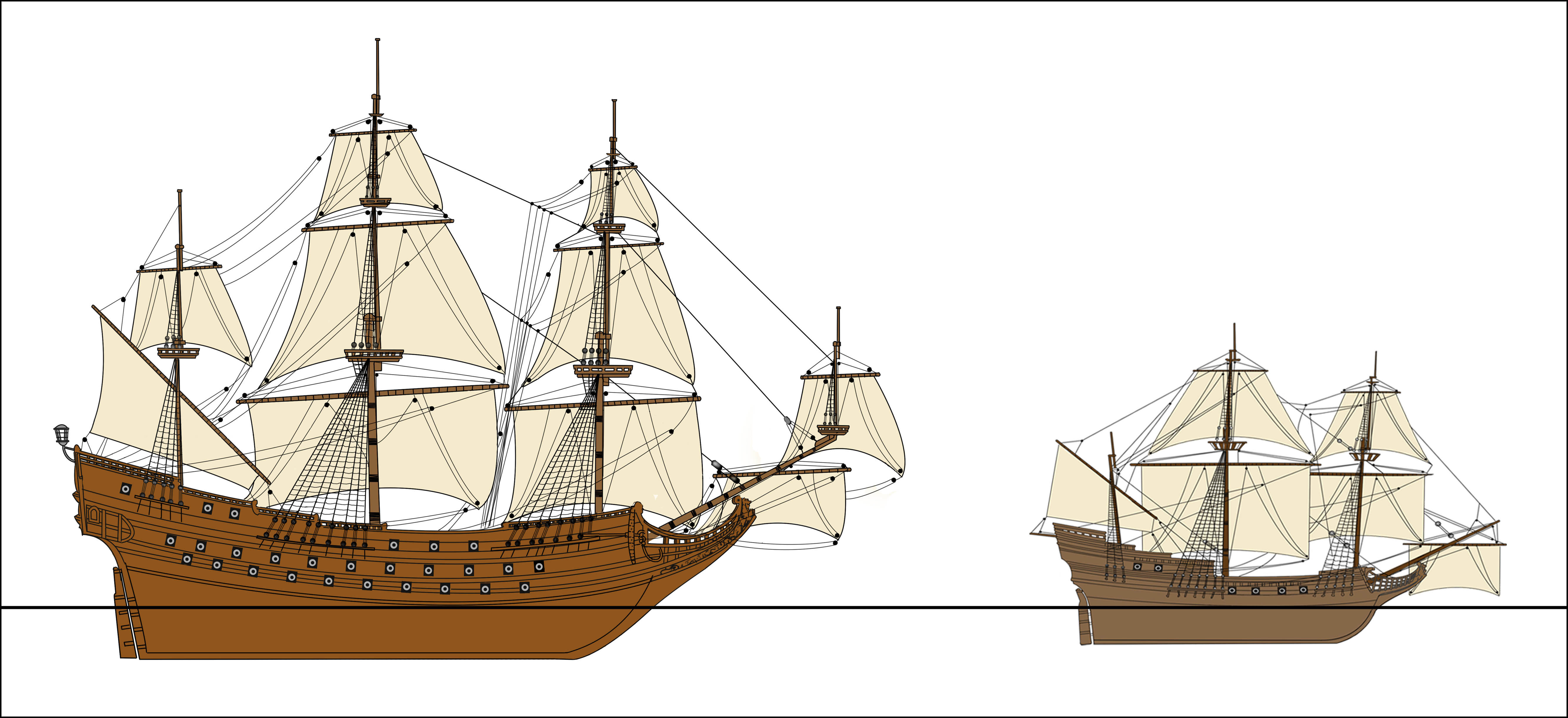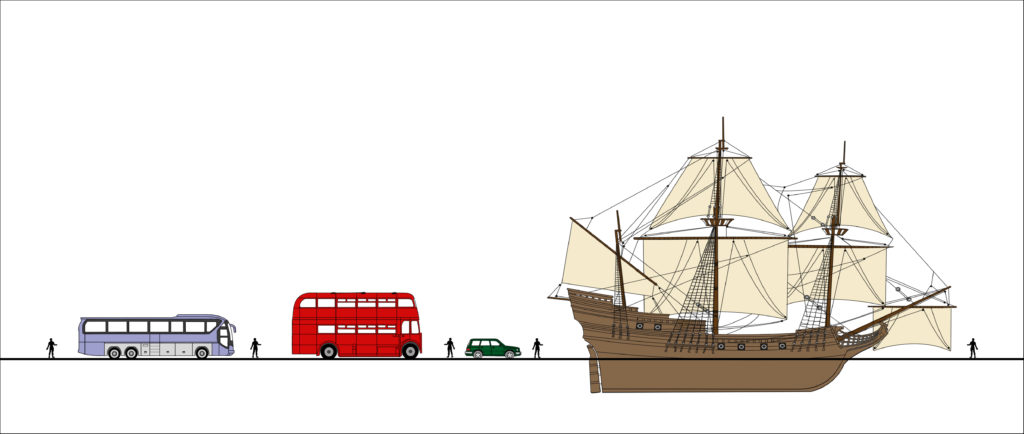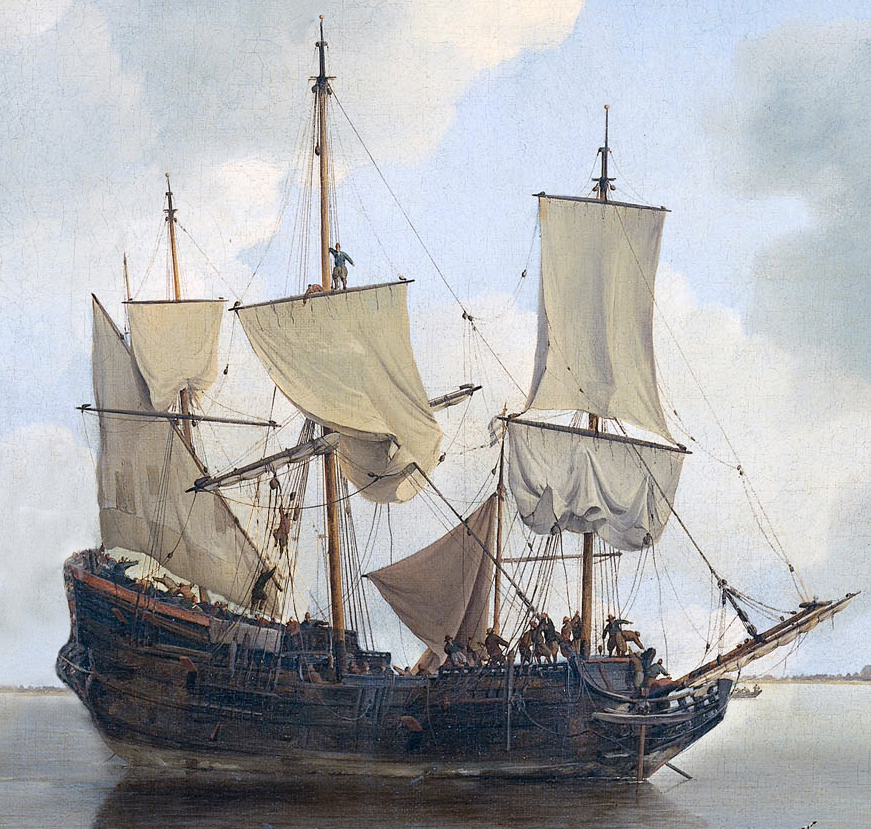(This post is a continuation of Corsair Ships: Square-Rigged Vessels – Part 1. If you haven’t done so already, it’s probably best to read that post before continuing on here.)
In the early seventeenth century, a large warship could be 140 feet (43 meters) long or more. Merchant ships, however, generally didn’t exceed 100 feet (30 meters), and many were smaller than that. The square-rigged ships used by Barbary corsairs varied in size, of course, but a typical vessel was about 80-90 feet (24 – 27 meters) long. This was also the size of vessel generally employed by the Dunkirkers (the Spanish-licensed privateers that operated out of Dunkirk), by English and Dutch privateers, and by pirates in general. It was large enough to still be intimidating, yet small enough to be fast and maneuverable and to have a reasonably shallow draft. Such a ship would have been armed with perhaps a dozen or so medium-sized cannon, not enough to threaten a warship, but sufficient to cow most merchant vessels, which were generally not loaded down with cannon.
The illustration above depicts a ship about 85 feet (26 meters) long riding at anchor, the crew in the process of furling the sails. You can clearly make out the crewmembers. Notice the man standing on the yard of the half-lowered topsail on the mainmast. You can get a clear sense of the relative dimensions of the ship using him as a gauge. As you can see, a ship like this may not have been a giant, but it was still a fairly hefty vessel when measured by the yardstick of the human body. If the man perched on the topsail yard were to slip and fall, he would plunge about 45 feet (14 meters) to the deck below him.
The illustration below depicts one of these 85-foot (26-meter) corsair vessels alongside a 140-foot (43-meter) warship. The two ships are to scale. The horizontal black line represents the waterline.

As you can clearly see, there’s a considerable difference in size between the two vessels. Seeing the two ships side by side makes it plain why Barbary corsairs avoided confrontations with large warships whenever possible.
To create a slightly different sense of relative sizes, the illustration below depicts an 85-foot/26-meter corsair ship alongside a modern cruise ship. Again, the two ships are to scale and the horizontal black line represents the waterline.

The cruise ship shown is depicted as being about 600 feet (183 meters) long. This is a common size for a cruise ship, though some are considerably larger. As you can see, by modern standards, an 85-foot/26-meter corsair ship is a very modest vessel indeed.
The above illustrations help to provide a sense of the relative sizes of these ships, but they don’t really provide any clear sense of what an 85-foot/26-meter sailing ship might look like if it pulled into a harbor near you. How big, exactly, does such a ship look when you stand alongside it?
The illustration below depicts such a ship alongside vehicles for which most people have an intuitive, experiential sense of scale: an intercity bus of the sort Greyhound operates in the US, a London double decker bus, and a compact SUV. The motor vehicles, the ship, and the human figures are all depicted to scale. The horizontal black line represents both the water line and the ground line.

As you can see, an 85-foot/26-meter sailing ship ends up being a sort of medium-large vessel. Its hull isn’t very much large than a pair of double decker buses laid nose to tail, and the main deck wouldn’t have had enough parking space for a Greyhound bus. But hauling oneself up the better part of 50 feet (15 meters) to the mainmast topsail yard would still have been a dangerous undertaking, and it was a vessel of sufficient size that it required a minimum crew of at least a dozen or more to handle it properly.
It was vessels like this that were the ‘workhorse’ ships of the Barbary corsair square-rigged fleet throughout the seventeenth century. Packed with men—corsairs maintained the largest crews they could, for purposes of intimidation—and armed as heavily as possible, such ships sailed throughout the Mediterranean and along the Atlantic littoral of Europe, raiding as far as the English Channel in the north and, westwards, to the Canary Islands, the Azores, and even far-distant Iceland. These ships were “good sailers” (in the language of the day): fast, maneuverable, and seaworthy, and the corsairs maintained their speediness by careening them—scraping the planked hulls clean of weed, barnacles, etc.—on a regular basis. As a result, they could outsail most of the ships they encountered—merchant or naval. Since their relatively shallow draft allowed them to get in close to land, they were used not only for chasing down merchant ships but also for disembarking men in shore raids. On the journey back to port, their holds would be packed with booty and groaning captives.
In August, 1626, the Mayor of Plymouth, England, wrote to the Privy Council complaining about the depredations of the ‘Turks’—the Barbary corsairs (that summer, mostly from Salé). That letter is recorded in the Calendar of State Papers Domestic: Charles I, in an entry dated August 12, 1626:
____________________
The Mayor and his Brethren of Plymouth to the Privy Council. Are enforced to write by the grievous complaints and daily losses which they receive through the Turks, who have taken in one year, besides ships, 1,000 mariners. Looe, in Cornwall, has in the last ten days lost 80 mariners, and within the same time there have been 27 ships and 200 persons taken. General fear for the ships from Virginia and Newfoundland. The pirates are 26 or 27 sail strong. Sir Francis Stewart sent out 5 ships against them, but they are far better sailers than the English ships. Within 3 days the English ships left them and returned to Falmouth.
____________________
The ships the “Turks” used to terrorize the English Channel were the sort of modestly sized, fast, well-armed, heavily crewed vessels discussed above. Against them, the British merchant ships returning from Virginia and the fishing craft coming home from the Grand Banks or Iceland with holds crammed with cod stood little chance—and naval ships could not catch the corsair ships.
The Barbary corsairs had perfected the European’s own weapons against them.

Corsairs and Captives
Narratives from the Age of the Barbary Pirates
View Amazon listing
The Travels of Reverend Ólafur Egilsson
The story of the Barbary corsair raid on Iceland in 1627
View Amazon listing